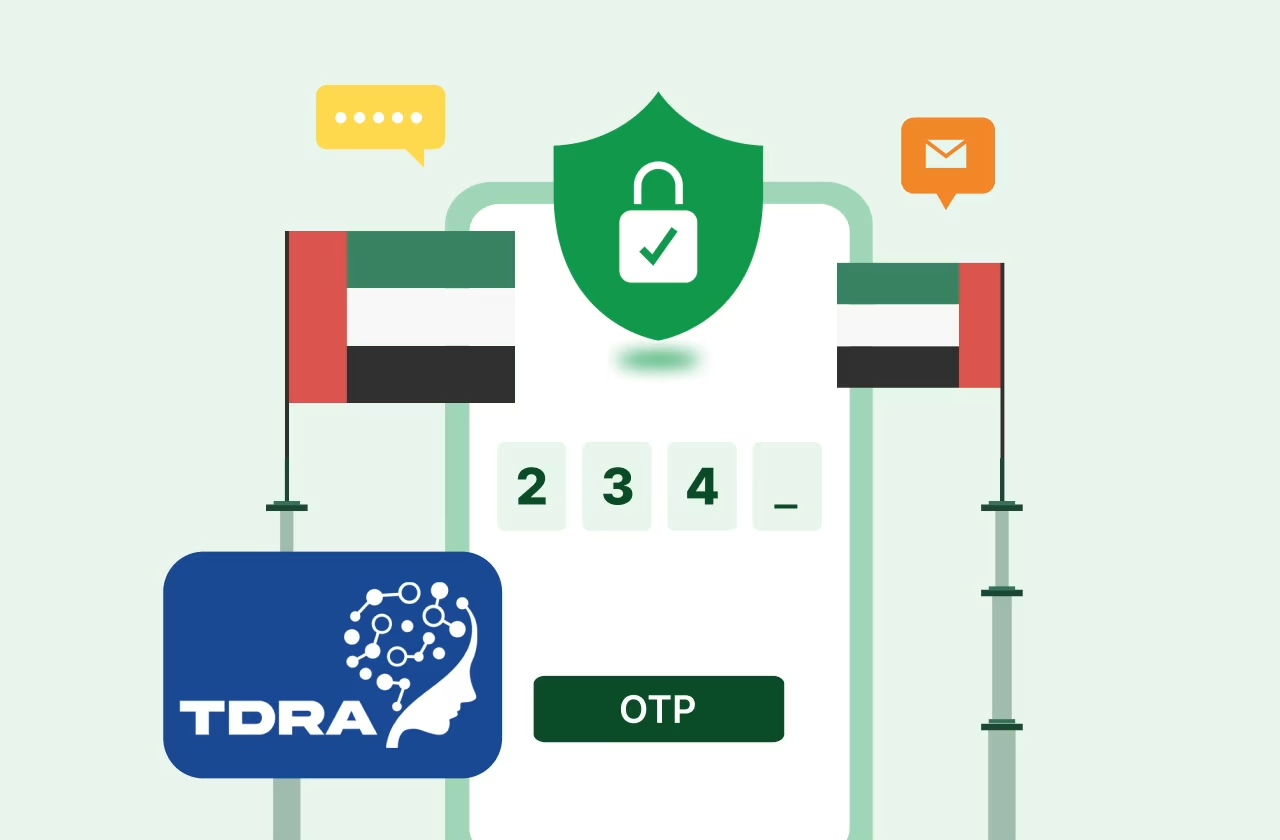Key Takeways
- Skip TDRA registration delays and send OTPs instantly in the UAE using VerifyNow’s pre-registered sender IDs.
- Traditional A2P sender ID registration in the UAE takes 7–15 business days and requires multiple compliance documents.
- VerifyNow by Message Central enables global OTP delivery to 190+ countries with one simple API integration.
- UAE’s 2026 OTP phase-out for banks highlights the growing shift toward multi-channel authentication like WhatsApp and RCS.
- Businesses using VerifyNow gain faster verification, higher conversions, and guaranteed TDRA compliance — all without paperwork.
Introduction
Imagine launching your app in the UAE and wanting to verify user phone numbers with a one-time password. Yet you hit a bottleneck: your sender ID must be registered with Telecommunications and Digital Government Regulatory Authority (TDRA) and local operators. That means approval delays, paperwork and possible fees, and your user is left hanging. Whether its setting up 2FA to secure your users or resetting passwords to recover accounts, OTPs are non-negotiable for a serious business.
Meanwhile the stakes are higher than ever. Research shows that over 87 % of large organisations now use multi-factor authentication (MFA) to protect user accounts. Other data indicates more than 56 % of IT professionals rely on SMS-based one-time codes in their security workflows. When your verification flow stalls because of telecom compliance hoops, you’re losing not only the moment of trust but also conversions.
In this article you will discover a smart, actionable way to send OTPs in the UAE right now, with no sender ID registration required on your end by using VerifyNow via Message Central. You’ll use pre-registered sender IDs allowing global delivery to 190+ countries with a simple API and clear steps. Let’s cut through the telecom noise and go straight to the results.
Why OTPs Matter (And Why Speed Is Everything)
Sending verification codes is not just a security measure, it is a conversion engine. When a user signs up, enters a phone number and waits for the code, every second counts. Long waits lead to dropouts.
SMS-based OTPs remain widely supported and trusted. For many apps they are still the fastest first channel. If your verification sequence is hung up by sender-ID registration you risk unnecessary friction.
Here’s the leadership angle others miss: it’s not just that you deliver the OTP—it’s when you deliver it and how seamlessly it lands in the user’s experience. That timing and reliability drive trust, brand perception and ultimately adoption.
What’s Really Going On in the UAE with Sender IDs
1. The formal requirements
In the UAE you must register your alphanumeric sender ID with operators and the TDRA before you send application-to-person (A2P) SMS. For example operator guides point out registration of trade licence documents, letters of authorization and other paperwork. According to one industry guide approvals can take 10–15 business days or more.
Also registration often incurs one-off fees and monthly recurring charges. If you’re running an OTP service you may end up with multiple sender IDs or toggling settings per region.
2. The hidden costs others don’t emphasise
- Time to market: each sender ID becomes a blocker.
- Testing complexity: sandbox flows become harder while waiting for approval.
- Global scale: you get locked into local registration processes in every new country.
- Conversion hit: when the verification step drags, users drop off.
In short if you are building a modern verification flow you can’t afford to wait for sender-ID registration.
P.S. Checkout the country-wise pricing for OTP SMS to compare and choose the best provider.
The Smart Move: Use Verify Now with Pre-registered IDs
Here is the smart path others overlook. Rather than registering your own sender ID, you leverage the pre‐registered IDs provided by Message Central via Verify Now. That means you can launch OTPs in UAE today, and scale globally with the same approach.
Why this gives you an edge
- The platform has already done the heavy lifting of registration with UAE operators on behalf of customers.
- You integrate the Verify Now API, choose the designated sender ID for UAE, send your OTP. No sender ID registration is required.
- You stay focused on your user experience, your product logic, your verification flow, not telecom bureaucracy.
- You get full global reach (190+ countries) using the same API and infrastructure.
What this means for you
- Speed: get live OTP delivery in minutes, not days.
- Simplicity: minimal setup, minimal overhead.
- Scalability: go from UAE to global markets with no incremental sender-ID burden.
- Authority: you show users a reliable verification channel backed by a robust platform.
Next step: Sign up on Message Central, claim your free credits and send your first OTP to a UAE number without any sender ID registration.
How to Implement VerifyNow in Minutes
Here is a developer-friendly, practical guide based on the official documentation from Message Central.
Step 1: Sign up and login
Head to Message Central. Create your free account. You’ll instantly receive free credits so you can test OTP delivery before going live.
Step 2: Generate your authentication token
According to the VerifyNow API documentation:
- Request URL: https://cpaas.messagecentral.com/auth/v1/authentication/token
- Required parameters: customerId, key (Base64-encoded password), optional country, optional email, always scope=NEW.
- You send a GET (or equivalent) request and you receive a token.
Example snippet (cURL):
curl --location 'https://cpaas.messagecentral.com/auth/v1/authentication/token?customerId=<CustomerId>&key=<Base64EncodedPassword>&scope=NEW&country=971'
--header 'accept: */*'In response you’ll receive JSON with status and token.
Step 3: Send OTP
- Use endpoint: /verification/v3/send
- Required parameters: customerId, countryCode, mobileNumber, flowType (set to SMS)
- You may optionally set otpLength (default is 4, but you can use 6 for stronger verification).
- Use your authToken in the header header.
Example snippet:
curl --location --request POST 'https://cpaas.messagecentral.com/verification/v3/send?countryCode=971&flowType=SMS&customerId=<CustomerId>&mobileNumber=9715XXXXXXXX' \
--header 'authToken: <YourToken>'In the JSON response you will receive responseCode: 200, verificationId, mobileNumber, timeout (in seconds) and transactionId.
Step 4: Validate OTP
Once the user enters the code you validate via the endpoint /verification/v3/validateOtp/.Required fields: verificationId, code, flowType.
Example:
curl --location 'https://cpaas.messagecentral.com/verification/v3/validateOtp?verificationId=2949&code=1476&flowType=SMS' \
--header 'authToken: <YourToken>'Success returns response code 200 and status VERIFICATION_COMPLETED.
Step 5: Monitor and scale
Check delivery logs, error codes (such as 700 – INVALID_COUNTRY_CODE, 702 – WRONG_OTP_PROVIDED), and set up your retry logic and time-outs. Outage or delivery issues should trigger fallback flows such as voice OTP or app push.
P.S. Checkout the complete API integration guide to integrate in less than 15 minutes!
Best practice tips
- Use OTP length 6 digits.
- Set timeout around 300 seconds or less to avoid standing verification windows.
- Limit retries to 2–3 attempts per session.
- Ensure you record user consent for OTP delivery in the UAE.
- Use the same workflow globally, changing only countryCode.
Deliverability, Compliance and Expert Edge
It’s not enough to send OTPs. You must deliver them reliably and remain fully compliant. That gives you true leadership in your domain.
Transactional vs Promotional content
In the UAE carriers strictly distinguish transactional messages (true OTPs, account alerts) from promotional messages (marketing blasts). Promotional SMS often require “AD-” prefix sender ID or extra registration. OTPs must be treated as transactional. If you use the Verify Now workflow correctly, your messages will remain in the transactional flow and not get flagged.
Local rules you cannot ignore
- Ensure the mobile number is in E.164 format (for UAE: +9715XXXXXXXX).
- Use SMS only for verification flows unless you have opted for WhatsApp fallback (also supported by Message Central).
- The content should be concise, include clear code instructions, and respect user privacy.
- Stay updated with TDRA guidelines. Operators update policy—they sometimes change sender ID requirements or block unknown IDs.
What others miss: the measurement and fallback layer
Many teams stop at “send the code” but overlook delivery monitoring and fallback logic. Real leaders instrument delivery receipts, classify error codes, implement voice or app-push fallback when SMS fails, track conversion rates post-OTP, and iterate. That kind of rigour distinguishes good from great.
Launch Day Checklist
Here is a quick, authoritative checklist before you press “go live”:
- Validate phone number input format and map to E.164.
- Create an account on Message Central Console and obtain API credentials.
- Generate token and test send in sandbox using free credits.
- Select the pre-registered sender ID for UAE via Verify Now.
- Send a real test to a UAE number and confirm delivery.
- Implement validation API for users entering the code.
- Set timeout for code expiry and implement retry limits.
- Log and monitor delivery receipts, error codes.
- Prepare fallback channel (voice/app push) for unreachable numbers.
- Ensure you have user consent logged for verification SMS.
- Configure production environment with appropriate monitoring and reporting.
Why This Approach Gives You a Competitive Edge
When you skip the sender ID registration burden and still deliver globally you gain speed, agility and credibility. Your engineering team spends time on product not telecom compliance. Your launch to UAE users is not delayed by days. Your verification flow is slick, reliable and builds trust.
From a thought leadership perspective you are signalling to your users and stakeholders that you understand the telecom stack and verification challenge deeply. You are not merely “sending codes” you are optimising the verification experience. That elevates your brand, your security posture and your operational maturity.
Conclusion & Your Next Step
If you’re preparing to verify mobile numbers in the UAE, the old way of registering your sender ID is a drag on speed and growth. A modern, agile verification flow uses Message Central’s Verify Now with pre-registered sender IDs. You get faster time to market, less overhead and a stronger user experience.
Ready to get started? Head to Message Central’s console, set up your account and let your users in the UAE verify their numbers today, without any sender ID registration on your end.
FAQs
What is the fastest way to send OTPs in the UAE without registering a TDRA sender ID?
The fastest way to deliver OTPs in the UAE is by using VerifyNow API, which provides pre-registered sender IDs approved with UAE operators. This allows instant OTP delivery without needing to go through the lengthy TDRA sender ID registration process, which can take 10–15 business days. You simply sign up, select a verified template, and send OTPs immediately through the API.
What are the current registration requirements for A2P sender IDs in the UAE and how long does the process take?
In the UAE, all A2P SMS sender IDs must be registered with TDRA through Etisalat or du before sending. You’ll need brand documents, sample templates, and ID approval — a process that usually takes 7–15 business days. Dormant IDs risk deactivation after 6 months.
With Message Central, you can skip long registrations and send via pre-approved sender IDs with direct UAE routes, ensuring instant delivery and TDRA compliance from day one.
How will the 2026 SMS OTP phase-out impact A2P authentication, and what’s next?
UAE regulators plan to phase out SMS OTPs for banks by 2026 to curb fraud, but other sectors (fintech, e-commerce, and logistics) will still rely heavily on A2P authentication. The shift is toward multi-channel verification via WhatsApp, RCS, and push.
VerifyNow by Message Central helps you future-proof with SMS, WhatsApp, and in-app OTP delivery, ensuring secure, fast, and compliant authentication across channels.










